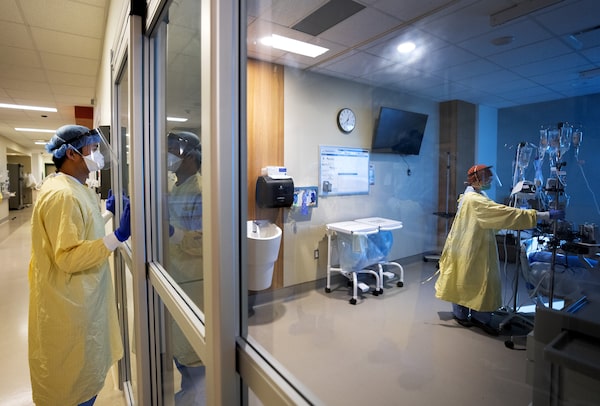
A health-care worker watches through protective glass as one of his colleagues attends to a COVID-19 patient on a ventilator in the intensive care unit at the Humber River Hospital during the COVID-19 pandemic in Toronto on Jan. 25.Nathan Denette/The Canadian Press
Welcome to the sixth wave of the pandemic, brought to you by a government near you.
April Fool’s joke? If only. Rising infection and hospitalization rates seen in many provinces this week are entirely due to provincial governments lifting most, if not all, of their indoor capacity limits, proof-of-vaccination mandates and mask mandates in March.
Now it’s April, and the expected consequences of those decisions – which were made just as a highly contagious Omicron subvariant, BA.2, was becoming dominant – are arriving right on schedule.
Quebec’s public-health institute confirmed Wednesday that the province is in the sixth wave of the COVID-19 pandemic, with B.A.2 accounting for two-thirds of new cases. Its modelling suggests 200 people a day will be admitted to hospital with the disease within two weeks. And that’s in a province where the indoor mask mandate is still in place until April 15.
In Ontario, where most capacity limits and passport mandates were lifted on March 1, and most mask mandates and any remaining capacity limits ended March 21, all the signs point to a sixth wave.
On Thursday, the province reported 807 people in hospital with COVID-19, the first time since March 4 that the number topped 800.
The previous Thursday, the count was 661.
Quebec enters sixth wave of COVID-19, public health institute confirms
Dr. Peter Juni, director of Ontario’s COVID-19 Science Table, said this week that the levels of COVID-19 found in wastewater are back to those seen in the winter Omicron wave that killed more than 7,000 Canadians.
In Canada as a whole, new cases have started to rise again, according to federal data.
It’s still too early to say whether the current numbers are the early warning signs of a huge wave that could swamp provincial health care systems. So far, death rates and ICU numbers have remained stable – no doubt due to Canada’s high vaccination rates. That’s the good news.
But what is galling is that governments knew that relaxing the rules would make people sick, and yet they have done next to nothing to mitigate the consequences of their actions. Quite the opposite, in fact.
Alberta, Manitoba, Saskatchewan, Prince Edward Island, New Brunswick and Nova Scotia have stopped releasing daily case counts, rendering it more difficult for their populations to make informed decisions about the state of the pandemic where they live.
Provinces have also cut back on testing, which means the limited testing they still do is an unreliable measure of how widespread the disease is. Federal data on Thursday showed that the country is now doing a seven-day average of 109 tests per 100,000 people on a daily basis. That’s a quarter of the testing done three months ago.
Worse still, the provinces have let their vaccination campaigns stall out, especially when it comes to booster shots.
Almost 86 per cent of people aged 5 and up in Canada are “fully vaccinated,” the official term for someone who has received two doses. But only 47 per cent have received a third dose, and that could prove to be disastrous as infections rise in this next wave of the pandemic.
Federal government data from March 13 show that a fully vaccinated person is three times less likely to be hospitalized for COVID-19 than an unvaccinated person, and four times less likely to die. But a person who has had a booster shot is almost seven times less likely to be hospitalized, and six times less likely to die.
When will COVID-19 be endemic? The four factors that will shape the virus’s future
That added protection could make all the difference. But it’s not surprising that, at a time when governments are telling people it’s safe to go without a mask, and that two shots is considered “fully vaccinated,” a tired population isn’t eagerly lining up for boosters.
It means that there are more than enough unvaccinated or unboosted people in Canada to produce the kind of surge in hospitalizations and deaths seen in past waves.
Provincial governments know this, and they aren’t doing a thing about it. It’s irresponsible, and it is made even worse by the fact politicians have no appetite for bringing back mask mandates and other protections.
On the contrary, the message from too many of them is that, as far as they are concerned, this thing is over and they are ready to move on. It could prove to be a fatal error.
Keep your Opinions sharp and informed. Get the Opinion newsletter. Sign up today.